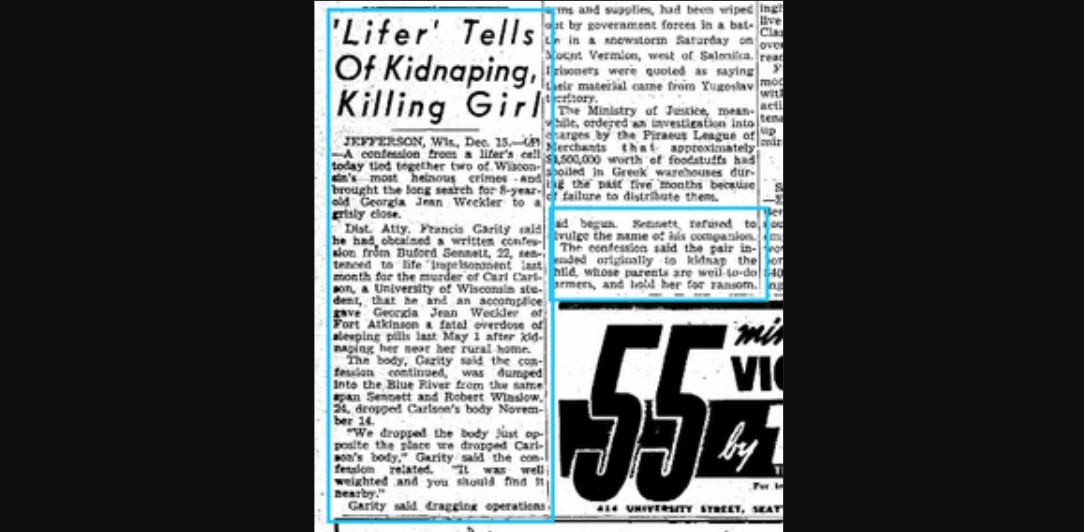In May 1947, 8-year-old Georgia Jean Weckler was dropped off after school at the end of her family’s farm, about half a mile from her home. That was the last time anyone saw her. It wasn’t until evening that her family realized she hadn’t returned and began searching for her. The case yielded very few leads, and when the police eventually identified a few suspects, it only raised more questions. Netflix’s ‘Monster: The Ed Gein Story’ explores the crimes of the notorious killer and examines whether he may have been involved in Georgia’s disappearance in any way.
Georgia Jean Weckler Was Last Seen Walking Towards Her Home With Mail in Her Hand
Born on June 27, 1938, Georgia Jean Weckler was the youngest child of George and Eleanor Weckler. Along with her siblings, Katherine, LaVerne, and Joanne, she enjoyed a comfortable and happy life, thanks to her parents’ success. The family owned a fairly large and fertile farm on the outskirts of Fort Atkinson, Wisconsin. Like her siblings, Georgia attended the Oakland Center School and was known as a sweet, cheerful girl who loved to play and was dearly adored by her parents. Usually, she and her siblings rode their bicycles to school, but on May 1, 1947, their mother decided to drive them because heavy rain had left the roads muddy.

After school ended, Georgia was given a ride home by her neighbor, Mrs. Carl Floerke, whose daughter Mary was in the same class. This was something Mrs. Floerke had done before. On the way back, she dropped the third-grader at the lane that stretched about half a mile from Highway 12 to the Weckler farmhouse. It was the usual spot where Georgia would get down and walk the rest of the way home. Mrs. Floerke later recalled seeing Georgia stop at the mailbox, pick up a stack of letters, and head toward the house before she drove off. However, Georgia never made it home. Around 6 pm, her family realized she was missing and raised the alarm. At first, they thought she might have stopped to pick wildflowers for May baskets and perhaps gotten injured on the way, but their search brought no answers.
Related
A Serial Offender Confessed to Georgia Jean Weckler’s Abduction
Hundreds of local residents joined the search for Georgia Weckler, as such a crime was unheard of in the area. Investigators initially suspected that the motive might have been ransom, but they had only one lead regarding a possible suspect. A neighbor reported seeing a vehicle in the vicinity around the time she disappeared. Police also found deep tire ruts in the gravel, which they believed had been caused by a car speeding away from the scene. At that time, 22-year-old Buford Sennett was already serving a sentence for a violent, sexually motivated crime. His previous targets reportedly matched Georgia’s description, and when questioned, he allegedly confessed to abducting her. Sennett claimed he and an accomplice had kidnapped Georgia for ransom, adding that she allegedly died after being given an overdose of sleeping pills.

Sennett claimed that, following her death, he disposed of her body in the Wisconsin River. Some details of the case had never been made public, and his account included information that suggested he might have been involved. The car he reportedly drove also matched the description police had recorded early in the investigation. However, detectives later found inconsistencies in his story, believing it to be a mixture of truth and fabrication. No evidence was found to support his claims, and authorities suspected that the crime had not occurred as he described. Sennett was eventually paroled, but in the 1980s, he was convicted again on sexual assault charges. When questioned about Georgia’s case once more, he recanted his earlier confession, which, since it had never been signed, held no legal weight.
Another lead investigated by police was the possible involvement of the infamous killer Ed Gein. In November 1957, Gein was arrested for the murders of Mary Hogan and Bernice Worden. Investigators also recovered other human remains from his property and questioned him about Georgia’s disappearance, but he denied any knowledge of it. At the time, Gein drove a black 1937 Ford, which matched the vehicle seen near the scene, though no other evidence linked him to the case. Some experts argued that Gein typically targeted women of his mother’s age, making it unlikely he would have harmed Georgia. The case remains unsolved to this day, and given the many years that have passed, it is considered extremely difficult to resolve.




You must be logged in to post a comment.